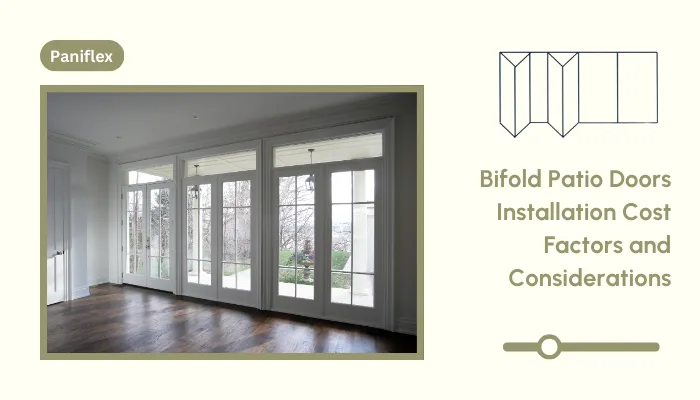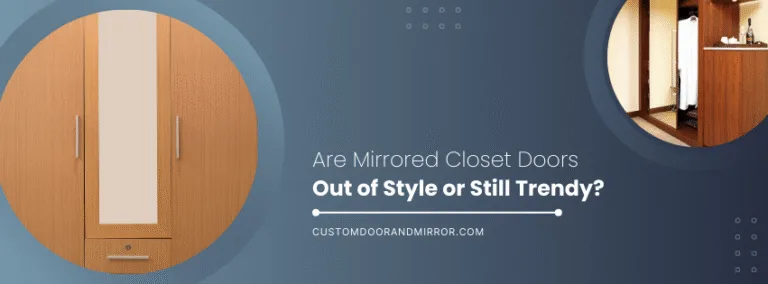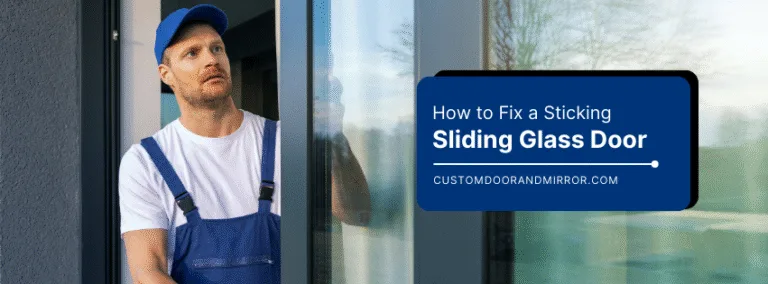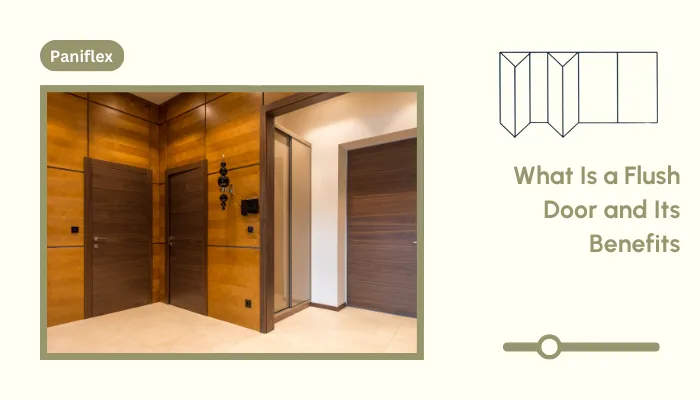Bifold patio doors bring modern sophistication to any project. They create seamless connections between indoor and outdoor spaces. However, their installation comes with a range of challenges that demand careful consideration. Overlooking key cost factors can result in budget overruns, extended timelines, or even compromised functionality.
Ready to experience the benefits of custom closet doors? Explore our range of Paniflex products now.
Achieving both aesthetic appeal and technical precision requires a thorough understanding of what drives installation costs. This includes the visible components, such as the doors themselves. Equally important are the often-overlooked details, including hardware quality, threshold design, and site-specific adjustments.
This guide explores the critical elements that influence bifold patio door installation costs. It provides a clear framework for accurate planning and efficient execution.

Cost Drivers for Installing Bifold Patio Doors
The cost of installing bifold patio doors depends on various interconnected factors. These elements influence both the upfront investment and the long-term value of the project. Understanding these cost drivers is essential for accurate budgeting and ensuring a successful installation.
Material Selection
The choice of material is one of the most significant factors influencing the cost and performance of bifold patio doors. Each material offers unique benefits and considerations:
- Aluminum: Lightweight yet strong, aluminum allows for slim profiles and expansive glass panels. It is highly durable and resistant to weathering, but its premium quality comes with a higher price point. Thermal breaks should be considered to improve insulation.
- Wood: Wood is a classic option for its natural beauty and warmth. Its bifold doors can complement traditional or rustic designs. However, they require regular maintenance to protect against moisture and warping, which can add long-term costs.
- Composite: Composite doors are versatile, durable, and low maintenance since they combine the strength of different materials. They are well-suited for projects requiring a balance between aesthetics and performance.
Key Insight: Material selection should be based on the site’s environmental conditions. For example, aluminum or composite doors are better suited for areas prone to humidity and corrosion, such as Long Island.
Glazing Options
Glazing plays a critical role in energy efficiency, sound insulation, and aesthetic appeal. The type of glass impacts both initial costs and long-term utility savings:
- Double Glazing: Provides solid thermal insulation and noise reduction, making it the standard choice for most installations.
- Triple Glazing enhances insulation and is ideal for projects in colder climates, but it also adds weight and cost.
- Low-E Glass: Reduces heat transfer while allowing natural light to pass through, improving energy efficiency.
- Custom Glazing: Frosted or tinted glass can add privacy or reduce glare, but these features increase the cost.
Consideration: Ensure compliance with local energy regulations, which often dictate the minimum U-value requirements for glazing.
Structural Adjustments
Installing bifold patio doors often requires structural modifications, especially when retrofitting them into an existing space. These adjustments can significantly affect costs:
- Load-Bearing Walls: If the installation requires removing or modifying load-bearing walls, structural reinforcements like steel beams will be needed.
- Threshold Design: Flush thresholds create a seamless transition but require precise leveling and waterproofing, which adds to their labor complexity.
- Framing: Proper framing is essential to support the weight of the doors and ensure smooth operation over time.
Tip: Always assess the existing structure before finalizing the door dimensions and configuration to avoid unexpected delays or additional costs.
Hardware and Mechanisms
The hardware used in bifold doors directly affects their durability and functionality. Investing in high-quality components ensures smooth operation and reduces maintenance needs:
- Tracks and Rollers: Stainless steel or aluminum tracks are durable and resistant to wear. They are essential for heavy doors or high-traffic areas.
- Hinges: Strong, corrosion-resistant hinges are crucial for maintaining door alignment and operation.
- Locking Systems: Multi-point locking systems enhance security but may increase upfront costs.
Insight: To prevent premature wear, hardware must be selected based on the panels’ weight and frequency of use.
Site Conditions and Customization
Every installation site presents unique challenges that influence the scope and cost of the project:
- Terrain: Uneven surfaces or sloping patios may require additional groundwork to create a level base.
- Custom Configurations: Non-standard panel sizes, finishes, or built-in blinds can significantly increase costs but elevate the project’s design impact.
- Weatherproofing: Proper seals and drainage systems are critical for protecting against leaks and drafts, especially in areas with extreme weather conditions.
Pro Tip: Incorporate site-specific considerations into the initial design phase to avoid costly revisions during installation.
Labor and Expertise
The complexity of bifold patio door installations requires skilled labor. The following factors influence labor costs:
- Experience Level: Hiring experienced installers reduces the likelihood of errors and ensures a faster, smoother process.
- Time Requirements: Complex projects, such as retrofits or installations requiring structural modifications, may take longer and cost more.
- Coordination: Projects with multiple trades, such as framers and electricians, require clear communication and precise scheduling to avoid delays.
Reminder: Proper budgeting for skilled labor is critical, as poorly executed installations can result in operational issues or increased maintenance costs.

How to Optimize Costs When Installing Bifold Patio Doors
Managing installation costs for bifold patio doors requires strategic planning and an eye for efficiency without sacrificing quality. Here’s a breakdown of practical measures to ensure cost optimization throughout the project:
Prioritize Pre-Planning and Coordination
Thorough pre-installation planning can prevent costly delays and unexpected expenses:
- Detailed Site Surveys: Conduct comprehensive surveys to identify potential challenges such as uneven terrain or structural modifications. Addressing these issues early minimizes surprises during installation.
- Project Timelines: Schedule delivery and labor to avoid idle time or rushed decisions that increase costs.
Actionable Insight: During the design phase, collaborate with all stakeholders, including framers and electricians, to streamline coordination and avoid overlapping tasks.
Invest Wisely in High-Impact Areas
Focus the budget on elements that provide the most value:
- Hardware Quality: Durable tracks, rollers, and hinges reduce maintenance costs and extend the lifespan of the installation.
- Energy-Efficient Glazing: Features like Low-E coatings and double glazing offer long-term utility savings without unnecessary upfront investment in triple glazing unless required by climate conditions.
Key Insight: Prioritize components that directly influence performance and longevity while avoiding unnecessary upgrades.
Optimize Labor Allocation
Skilled labor is essential for bifold patio doors, but costs can be managed by allocating resources efficiently:
- Expert Oversight: Use experienced installers for critical tasks like aligning tracks and frames. Delegate simpler tasks, such as site preparation, to less specialized workers.
- Batch Installations: For larger projects, install multiple units in one phase to reduce setup and teardown costs.
Technical Note: Ensure labor contracts are clear about scope and timelines to avoid disputes or additional charges.
Source Materials Strategically
Material costs can be optimized by working with trusted suppliers and exploring bulk purchasing options:
- Local Vendors: Reduce transportation costs and lead times by sourcing materials locally whenever possible.
- Bulk Discounts: For multi-unit projects, negotiate bulk pricing on doors, hardware, and glazing.
Supply Chain Insight: Partner with suppliers who offer warranties and post-installation support to protect against future expenses.
Simplify Site Modifications
Structural adjustments can drive up costs, so minimizing their scope is crucial:
- Frame Compatibility: Design around existing structural elements to avoid major reinforcements or demolition.
- Gradual Adjustments: Use shims and minor grading for uneven terrain instead of extensive groundwork.
Construction Tip: Work closely with engineers and framers to identify cost-effective solutions for structural challenges.
Custom Bifold Patio Doors are Cost-effective
Custom bifold patio doors may seem like a premium option at first glance, but their long-term value makes them a cost-effective choice for projects that demand both functionality and aesthetic appeal.
Here’s why custom bifold doors offer more value than you might expect:
| Reason | Details | Technical Insight |
| Tailored to Maximize Space | Custom bifold doors fit exact dimensions, eliminating the need for structural modifications, reducing installation time, and ensuring seamless integration. | Precision manufacturing ensures door panels are within ±1mm tolerance for exact alignment and smooth operation. |
| Built to Last with High-Quality Materials | Durable materials like aluminum and composite offer long-lasting performance with minimal maintenance. Custom features, like corrosion-resistant coatings, suit harsh weather conditions. | Aluminum frames with anodized or powder-coated finishes resist wear, while composite materials prevent warping. |
| Energy Efficiency Reduces Operational Costs | Incorporates advanced technologies such as insulated glass, Low-E coatings, and thermally broken frames to reduce heating and cooling costs over time. | Thermally broken aluminum frames reduce heat transfer by up to 40%, improving indoor comfort and energy savings. |
| Customization Enhances Property Value | Custom options, like integrated blinds and unique finishes, elevate aesthetics and functionality, making properties more attractive to buyers or tenants. | Integrated blinds are sealed between glass panels, ensuring dust-free operation and minimal maintenance. |
| Efficient Installation Saves Time and Money | Exact specifications reduce on-site adjustments, speeding up installation and lowering labor costs. Pre-fitted frames ensure precise alignment. | CNC-machined frames allow for quick on-site assembly and reduce alignment errors during installation. |
| Low Maintenance Requirements | Includes high-quality hardware and weather sealing, reducing upkeep costs and extending the lifespan of the doors. | Stainless steel rollers and tracks are tested to withstand 100,000 open/close cycles under full load conditions. |
Custom bifold patio doors are more than just a design choice—they are a smart investment in quality, functionality, and long-term value. They integrate indoor and outdoor spaces, improve energy efficiency, and enhance property aesthetics, offering a versatile solution for various projects.
Why Choose Custom Door & Mirror for Your Bifold Patio Door Needs?
The true value lies in selecting a trusted manufacturer who understands your project’s unique technical requirements and design goals. At Custom Door & Mirror, we combine advanced engineering with superior craftsmanship to deliver bifold patio doors that meet your specifications.
Our advanced manufacturing process ensures every door is custom-built to exact specifications, minimizing installation complexities and guaranteeing a seamless fit. Whether you need corrosion-resistant aluminum for coastal properties or energy-efficient glazing for urban spaces, we offer various materials and finishes to suit diverse requirements.
When you work with Custom Door & Mirror, you are not just getting doors but investing in reliability, innovation, and a partner who understands the technical needs of architects, designers, and contractors. From pre-fitted frames to high-performance hardware, our products are engineered for longevity and ease of installation.
Ready to experience the benefits of custom closet doors? Explore our range of Paniflex products now.
Schedule a consultation today. Call (631)-414-7725 or use our online form.
Frequently Asked Questions
How do large bifold door configurations affect installation timelines?
Multi-panel configurations increase installation complexity, requiring precise alignment and additional hardware adjustments. Ensuring the frame is reinforced and perfectly level is critical to avoid delays caused by operational issues.
What are the cost implications of integrating automation or smart features?
Automated bifold doors with motorized tracks or smart locks add upfront costs for hardware and installation but provide long-term convenience and enhanced security. Integration with existing smart home systems may require additional wiring or compatibility assessments.
Are there any hidden costs in retrofitting bifold patio doors?
Retrofitting often uncovers unforeseen issues, such as structural reinforcements for older frames, rerouting utilities, or repairing existing damage. Conducting a detailed pre-installation survey helps identify potential hidden costs.
How do threshold designs impact functionality and cost?
Flush thresholds offer seamless transitions but require precise leveling, advanced drainage systems, and weatherproofing, increasing labor and material costs. Raised thresholds are less complex to install but may compromise accessibility. Choosing the right threshold depends on project priorities.






